Comprehensive Analysis: Australian Public Health Policy 2019 Report
VerifiedAdded on 2023/01/18
|17
|3364
|76
Report
AI Summary
This report provides a comprehensive overview of Australia's Public Health Policy 2019, which aims to replace previous frameworks and policies. It establishes guidelines for healthcare providers, emphasizing national importance and covering various aspects of public health. The policy addresses areas such as health promotion, chronic and communicable disease prevention, environmental health management, disaster preparedness, screening and genomics, and poisons and medicines management. It outlines key principles like consistency, evidence-based practices, population focus, and risk management. The report also references relevant legislation and details policy frameworks for each area, including specific measures for disease prevention, health promotion, environmental health control, disaster response, and the management of poisons and medicines. The policy emphasizes the need for preparedness, education, and effective management strategies to protect and improve the health of Australian citizens.
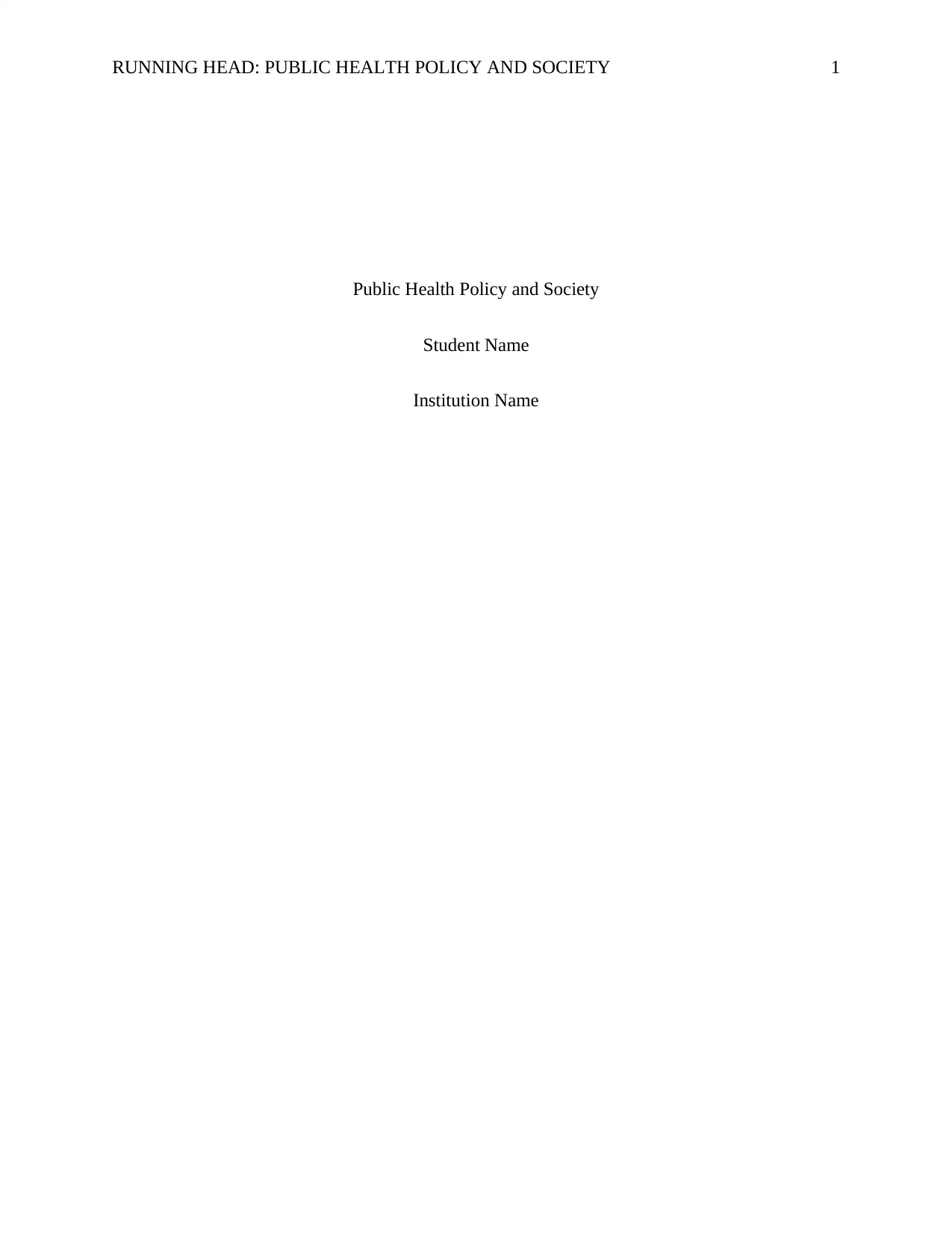
RUNNING HEAD: PUBLIC HEALTH POLICY AND SOCIETY 1
Public Health Policy and Society
Student Name
Institution Name
Public Health Policy and Society
Student Name
Institution Name
Paraphrase This Document
Need a fresh take? Get an instant paraphrase of this document with our AI Paraphraser
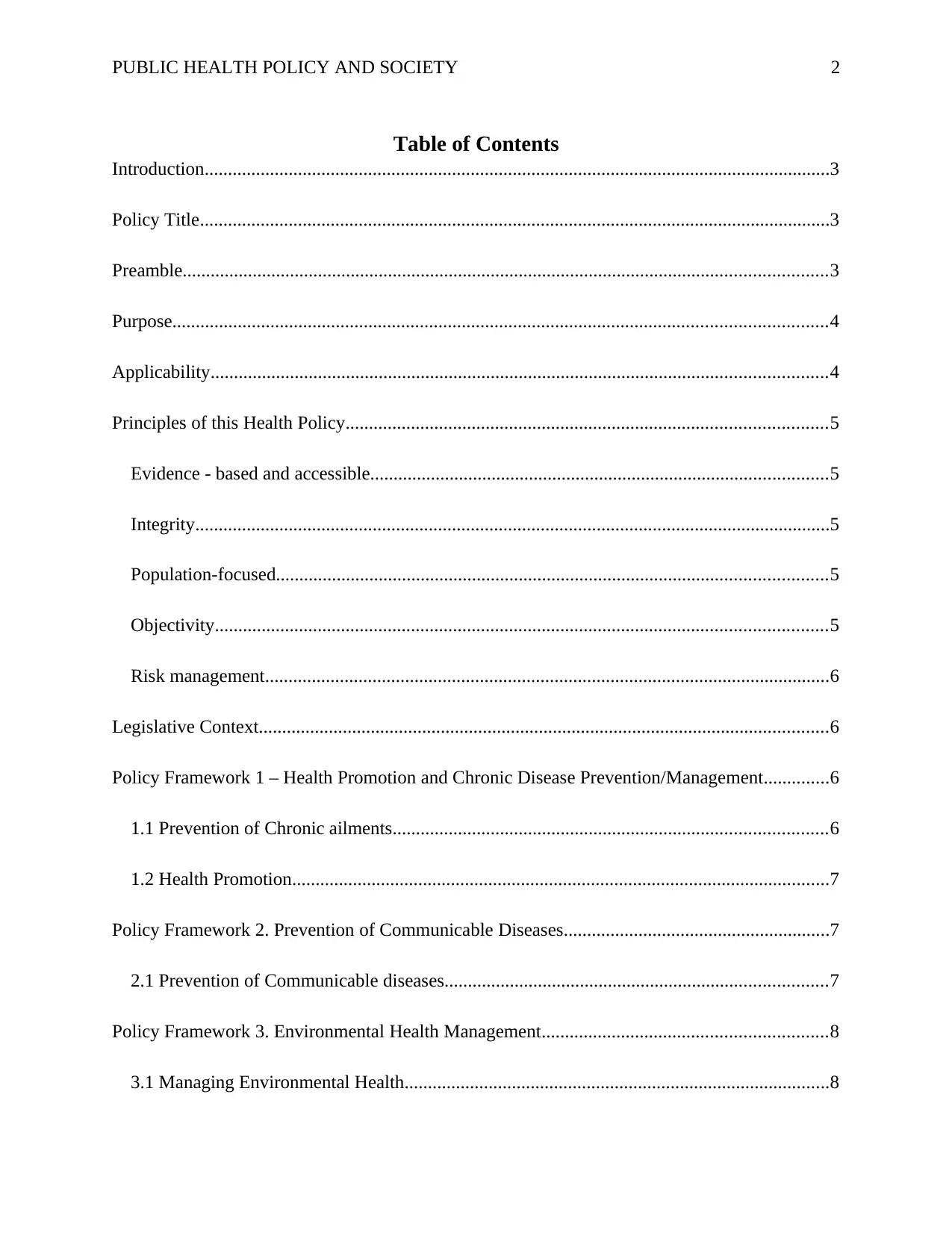
PUBLIC HEALTH POLICY AND SOCIETY 2
Table of Contents
Introduction......................................................................................................................................3
Policy Title.......................................................................................................................................3
Preamble..........................................................................................................................................3
Purpose............................................................................................................................................4
Applicability....................................................................................................................................4
Principles of this Health Policy.......................................................................................................5
Evidence - based and accessible..................................................................................................5
Integrity........................................................................................................................................5
Population-focused......................................................................................................................5
Objectivity...................................................................................................................................5
Risk management.........................................................................................................................6
Legislative Context..........................................................................................................................6
Policy Framework 1 – Health Promotion and Chronic Disease Prevention/Management..............6
1.1 Prevention of Chronic ailments.............................................................................................6
1.2 Health Promotion...................................................................................................................7
Policy Framework 2. Prevention of Communicable Diseases.........................................................7
2.1 Prevention of Communicable diseases..................................................................................7
Policy Framework 3. Environmental Health Management.............................................................8
3.1 Managing Environmental Health...........................................................................................8
Table of Contents
Introduction......................................................................................................................................3
Policy Title.......................................................................................................................................3
Preamble..........................................................................................................................................3
Purpose............................................................................................................................................4
Applicability....................................................................................................................................4
Principles of this Health Policy.......................................................................................................5
Evidence - based and accessible..................................................................................................5
Integrity........................................................................................................................................5
Population-focused......................................................................................................................5
Objectivity...................................................................................................................................5
Risk management.........................................................................................................................6
Legislative Context..........................................................................................................................6
Policy Framework 1 – Health Promotion and Chronic Disease Prevention/Management..............6
1.1 Prevention of Chronic ailments.............................................................................................6
1.2 Health Promotion...................................................................................................................7
Policy Framework 2. Prevention of Communicable Diseases.........................................................7
2.1 Prevention of Communicable diseases..................................................................................7
Policy Framework 3. Environmental Health Management.............................................................8
3.1 Managing Environmental Health...........................................................................................8
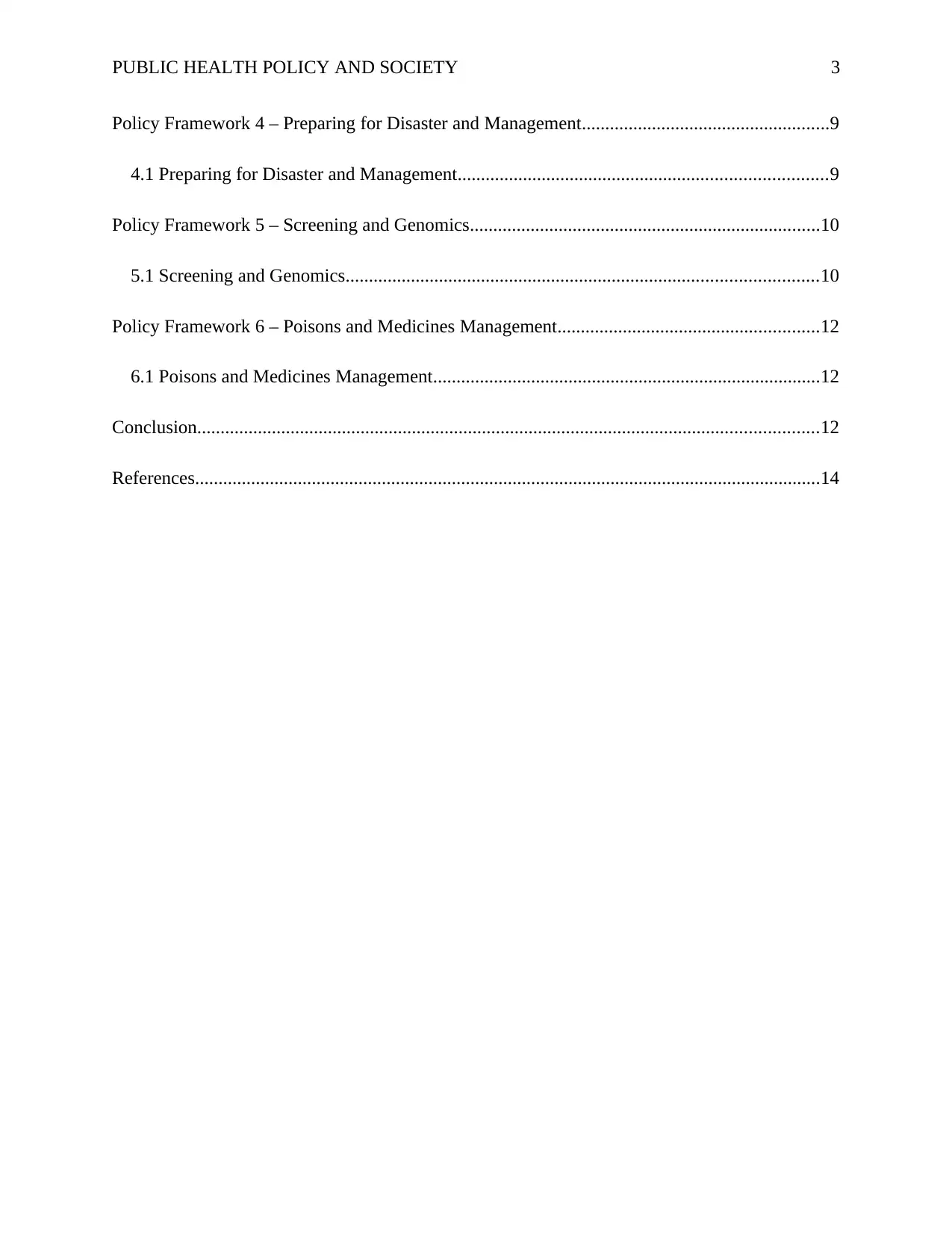
PUBLIC HEALTH POLICY AND SOCIETY 3
Policy Framework 4 – Preparing for Disaster and Management.....................................................9
4.1 Preparing for Disaster and Management...............................................................................9
Policy Framework 5 – Screening and Genomics...........................................................................10
5.1 Screening and Genomics.....................................................................................................10
Policy Framework 6 – Poisons and Medicines Management........................................................12
6.1 Poisons and Medicines Management...................................................................................12
Conclusion.....................................................................................................................................12
References......................................................................................................................................14
Policy Framework 4 – Preparing for Disaster and Management.....................................................9
4.1 Preparing for Disaster and Management...............................................................................9
Policy Framework 5 – Screening and Genomics...........................................................................10
5.1 Screening and Genomics.....................................................................................................10
Policy Framework 6 – Poisons and Medicines Management........................................................12
6.1 Poisons and Medicines Management...................................................................................12
Conclusion.....................................................................................................................................12
References......................................................................................................................................14
⊘ This is a preview!⊘
Do you want full access?
Subscribe today to unlock all pages.

Trusted by 1+ million students worldwide
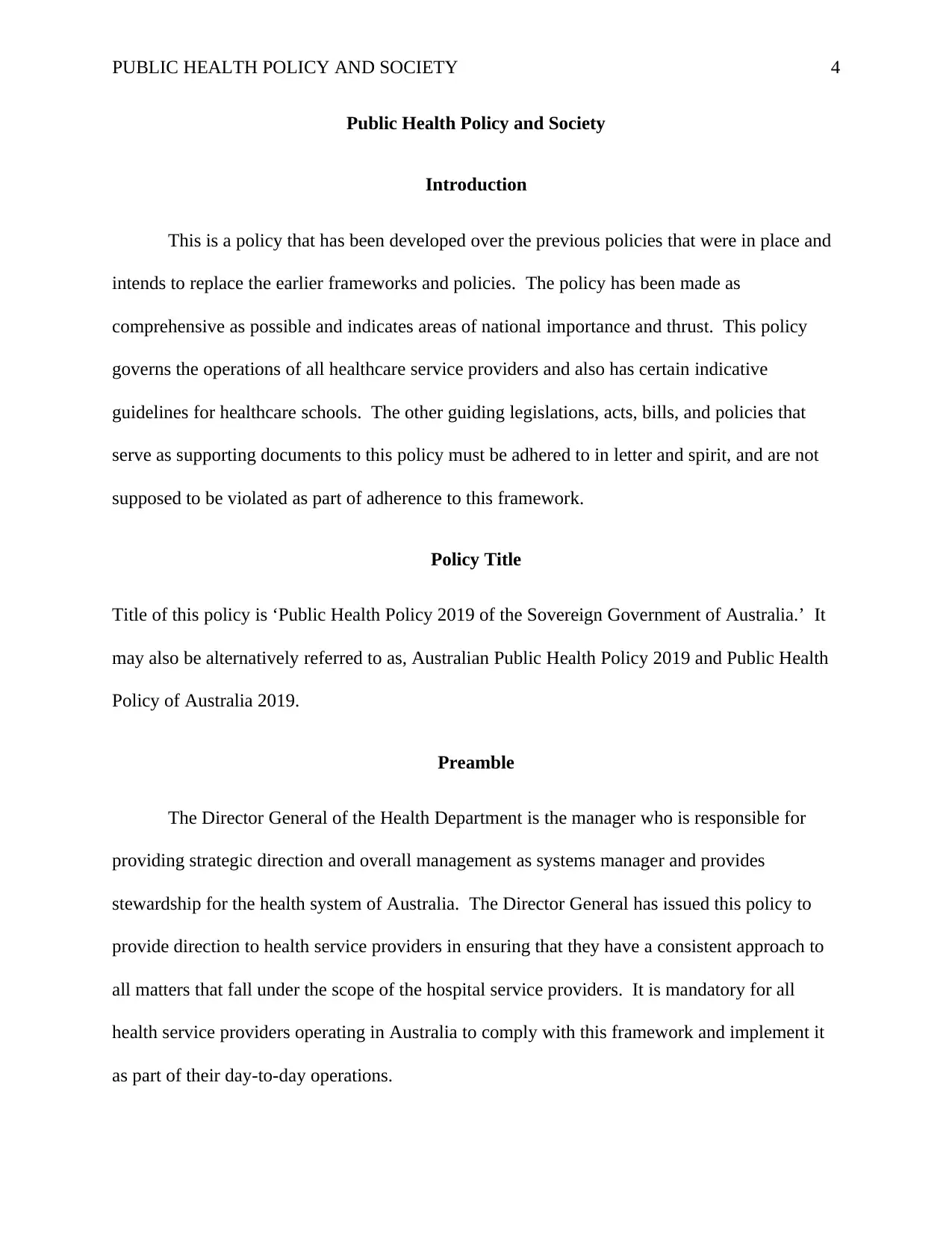
PUBLIC HEALTH POLICY AND SOCIETY 4
Public Health Policy and Society
Introduction
This is a policy that has been developed over the previous policies that were in place and
intends to replace the earlier frameworks and policies. The policy has been made as
comprehensive as possible and indicates areas of national importance and thrust. This policy
governs the operations of all healthcare service providers and also has certain indicative
guidelines for healthcare schools. The other guiding legislations, acts, bills, and policies that
serve as supporting documents to this policy must be adhered to in letter and spirit, and are not
supposed to be violated as part of adherence to this framework.
Policy Title
Title of this policy is ‘Public Health Policy 2019 of the Sovereign Government of Australia.’ It
may also be alternatively referred to as, Australian Public Health Policy 2019 and Public Health
Policy of Australia 2019.
Preamble
The Director General of the Health Department is the manager who is responsible for
providing strategic direction and overall management as systems manager and provides
stewardship for the health system of Australia. The Director General has issued this policy to
provide direction to health service providers in ensuring that they have a consistent approach to
all matters that fall under the scope of the hospital service providers. It is mandatory for all
health service providers operating in Australia to comply with this framework and implement it
as part of their day-to-day operations.
Public Health Policy and Society
Introduction
This is a policy that has been developed over the previous policies that were in place and
intends to replace the earlier frameworks and policies. The policy has been made as
comprehensive as possible and indicates areas of national importance and thrust. This policy
governs the operations of all healthcare service providers and also has certain indicative
guidelines for healthcare schools. The other guiding legislations, acts, bills, and policies that
serve as supporting documents to this policy must be adhered to in letter and spirit, and are not
supposed to be violated as part of adherence to this framework.
Policy Title
Title of this policy is ‘Public Health Policy 2019 of the Sovereign Government of Australia.’ It
may also be alternatively referred to as, Australian Public Health Policy 2019 and Public Health
Policy of Australia 2019.
Preamble
The Director General of the Health Department is the manager who is responsible for
providing strategic direction and overall management as systems manager and provides
stewardship for the health system of Australia. The Director General has issued this policy to
provide direction to health service providers in ensuring that they have a consistent approach to
all matters that fall under the scope of the hospital service providers. It is mandatory for all
health service providers operating in Australia to comply with this framework and implement it
as part of their day-to-day operations.
Paraphrase This Document
Need a fresh take? Get an instant paraphrase of this document with our AI Paraphraser
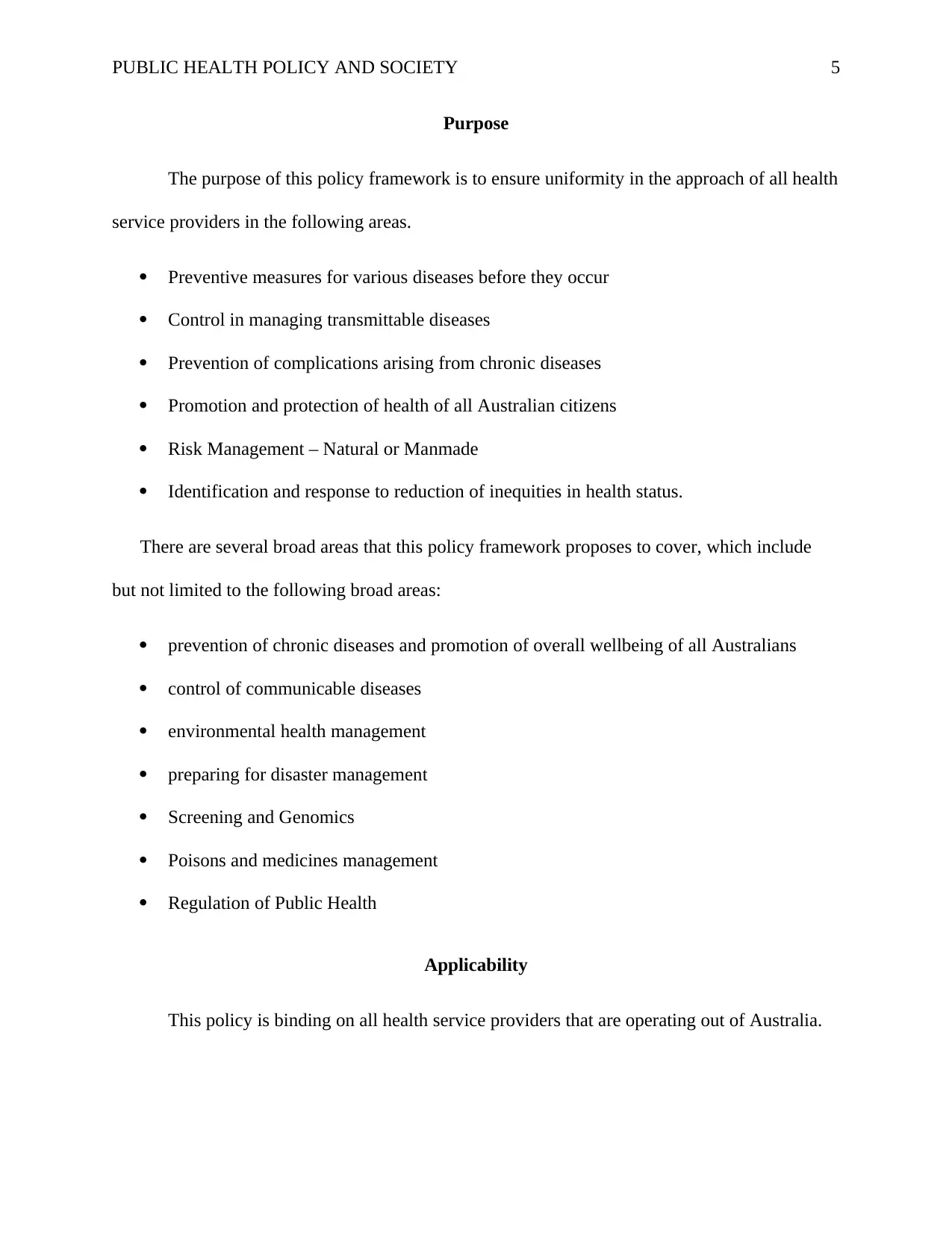
PUBLIC HEALTH POLICY AND SOCIETY 5
Purpose
The purpose of this policy framework is to ensure uniformity in the approach of all health
service providers in the following areas.
Preventive measures for various diseases before they occur
Control in managing transmittable diseases
Prevention of complications arising from chronic diseases
Promotion and protection of health of all Australian citizens
Risk Management – Natural or Manmade
Identification and response to reduction of inequities in health status.
There are several broad areas that this policy framework proposes to cover, which include
but not limited to the following broad areas:
prevention of chronic diseases and promotion of overall wellbeing of all Australians
control of communicable diseases
environmental health management
preparing for disaster management
Screening and Genomics
Poisons and medicines management
Regulation of Public Health
Applicability
This policy is binding on all health service providers that are operating out of Australia.
Purpose
The purpose of this policy framework is to ensure uniformity in the approach of all health
service providers in the following areas.
Preventive measures for various diseases before they occur
Control in managing transmittable diseases
Prevention of complications arising from chronic diseases
Promotion and protection of health of all Australian citizens
Risk Management – Natural or Manmade
Identification and response to reduction of inequities in health status.
There are several broad areas that this policy framework proposes to cover, which include
but not limited to the following broad areas:
prevention of chronic diseases and promotion of overall wellbeing of all Australians
control of communicable diseases
environmental health management
preparing for disaster management
Screening and Genomics
Poisons and medicines management
Regulation of Public Health
Applicability
This policy is binding on all health service providers that are operating out of Australia.
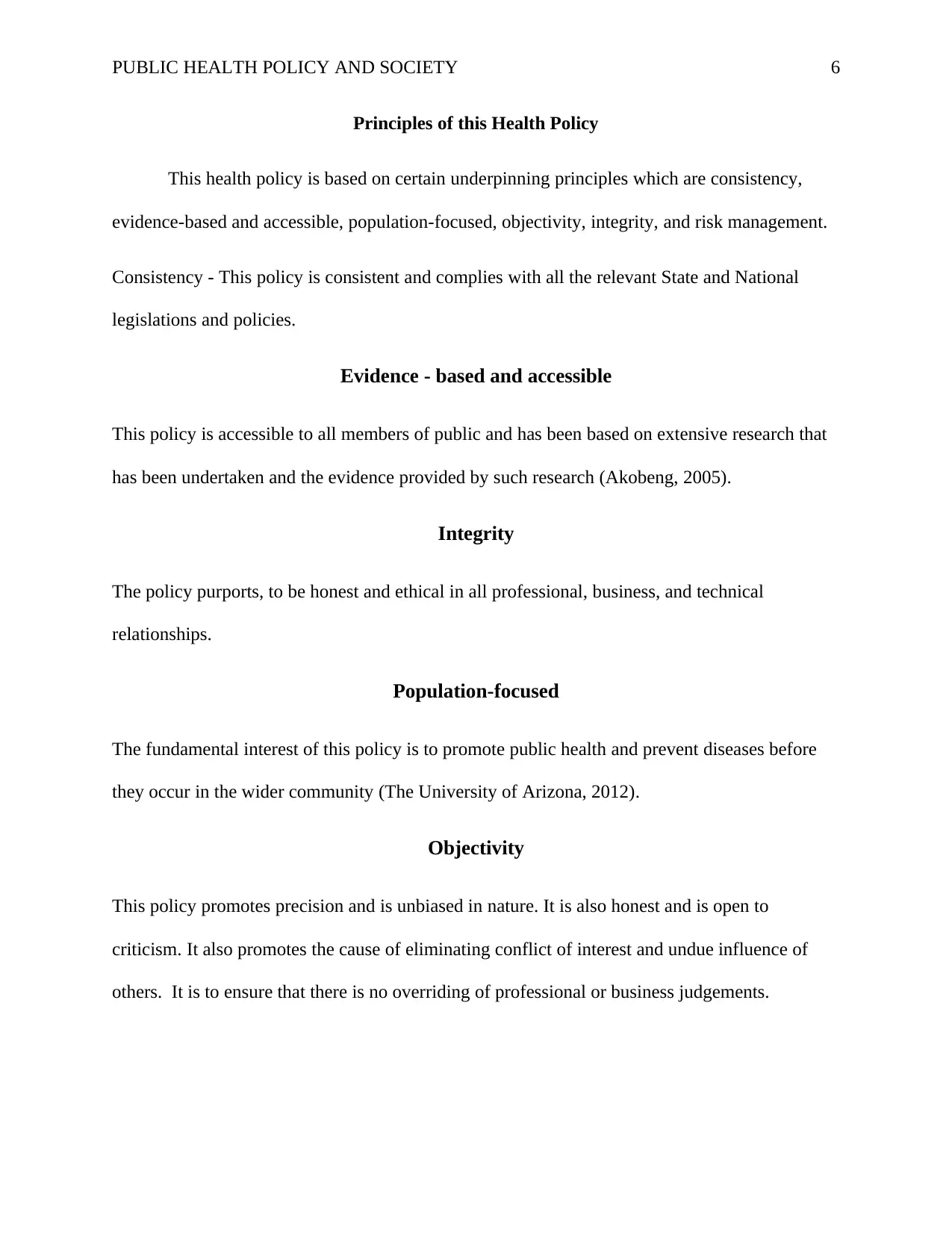
PUBLIC HEALTH POLICY AND SOCIETY 6
Principles of this Health Policy
This health policy is based on certain underpinning principles which are consistency,
evidence-based and accessible, population-focused, objectivity, integrity, and risk management.
Consistency - This policy is consistent and complies with all the relevant State and National
legislations and policies.
Evidence - based and accessible
This policy is accessible to all members of public and has been based on extensive research that
has been undertaken and the evidence provided by such research (Akobeng, 2005).
Integrity
The policy purports, to be honest and ethical in all professional, business, and technical
relationships.
Population-focused
The fundamental interest of this policy is to promote public health and prevent diseases before
they occur in the wider community (The University of Arizona, 2012).
Objectivity
This policy promotes precision and is unbiased in nature. It is also honest and is open to
criticism. It also promotes the cause of eliminating conflict of interest and undue influence of
others. It is to ensure that there is no overriding of professional or business judgements.
Principles of this Health Policy
This health policy is based on certain underpinning principles which are consistency,
evidence-based and accessible, population-focused, objectivity, integrity, and risk management.
Consistency - This policy is consistent and complies with all the relevant State and National
legislations and policies.
Evidence - based and accessible
This policy is accessible to all members of public and has been based on extensive research that
has been undertaken and the evidence provided by such research (Akobeng, 2005).
Integrity
The policy purports, to be honest and ethical in all professional, business, and technical
relationships.
Population-focused
The fundamental interest of this policy is to promote public health and prevent diseases before
they occur in the wider community (The University of Arizona, 2012).
Objectivity
This policy promotes precision and is unbiased in nature. It is also honest and is open to
criticism. It also promotes the cause of eliminating conflict of interest and undue influence of
others. It is to ensure that there is no overriding of professional or business judgements.
⊘ This is a preview!⊘
Do you want full access?
Subscribe today to unlock all pages.

Trusted by 1+ million students worldwide
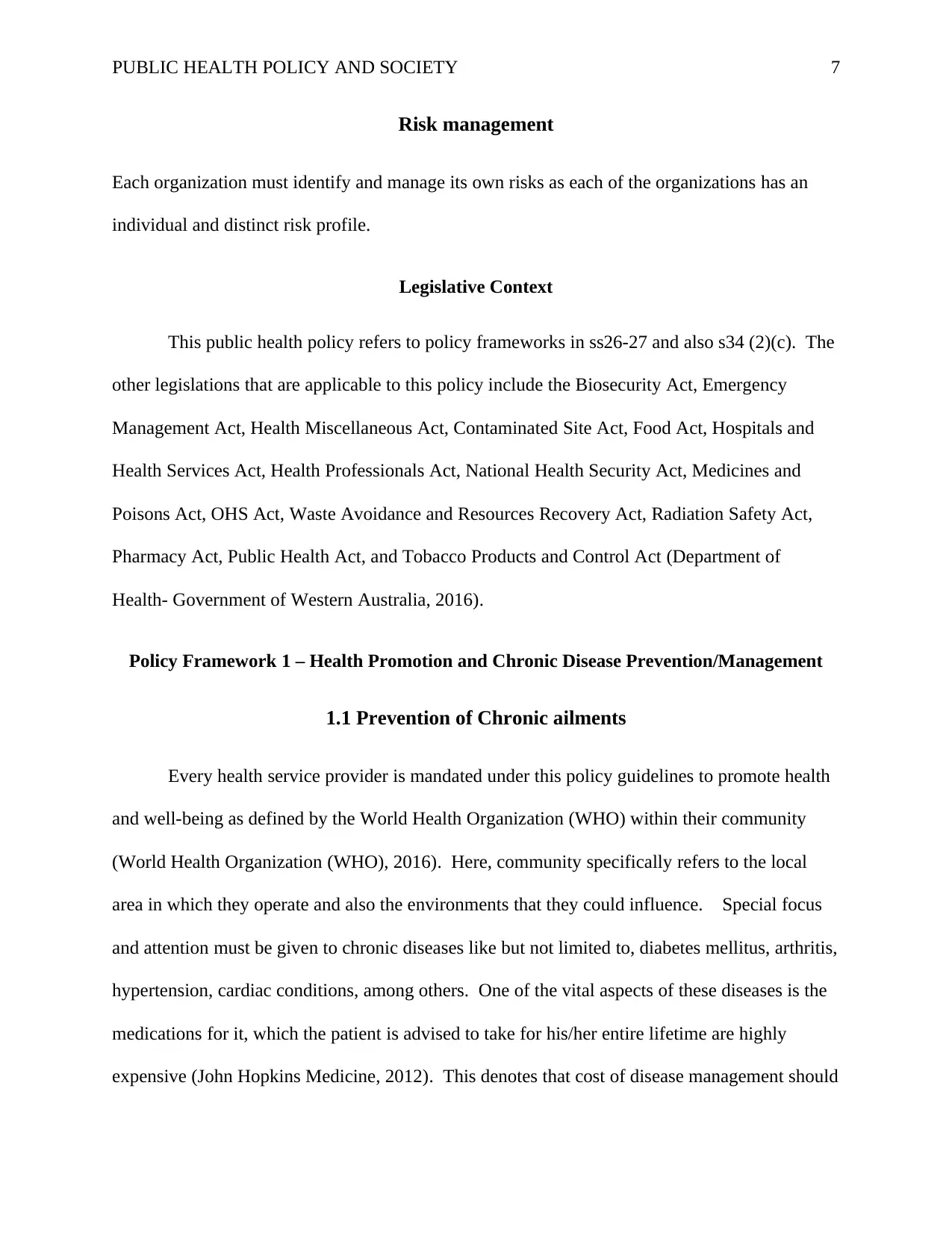
PUBLIC HEALTH POLICY AND SOCIETY 7
Risk management
Each organization must identify and manage its own risks as each of the organizations has an
individual and distinct risk profile.
Legislative Context
This public health policy refers to policy frameworks in ss26-27 and also s34 (2)(c). The
other legislations that are applicable to this policy include the Biosecurity Act, Emergency
Management Act, Health Miscellaneous Act, Contaminated Site Act, Food Act, Hospitals and
Health Services Act, Health Professionals Act, National Health Security Act, Medicines and
Poisons Act, OHS Act, Waste Avoidance and Resources Recovery Act, Radiation Safety Act,
Pharmacy Act, Public Health Act, and Tobacco Products and Control Act (Department of
Health- Government of Western Australia, 2016).
Policy Framework 1 – Health Promotion and Chronic Disease Prevention/Management
1.1 Prevention of Chronic ailments
Every health service provider is mandated under this policy guidelines to promote health
and well-being as defined by the World Health Organization (WHO) within their community
(World Health Organization (WHO), 2016). Here, community specifically refers to the local
area in which they operate and also the environments that they could influence. Special focus
and attention must be given to chronic diseases like but not limited to, diabetes mellitus, arthritis,
hypertension, cardiac conditions, among others. One of the vital aspects of these diseases is the
medications for it, which the patient is advised to take for his/her entire lifetime are highly
expensive (John Hopkins Medicine, 2012). This denotes that cost of disease management should
Risk management
Each organization must identify and manage its own risks as each of the organizations has an
individual and distinct risk profile.
Legislative Context
This public health policy refers to policy frameworks in ss26-27 and also s34 (2)(c). The
other legislations that are applicable to this policy include the Biosecurity Act, Emergency
Management Act, Health Miscellaneous Act, Contaminated Site Act, Food Act, Hospitals and
Health Services Act, Health Professionals Act, National Health Security Act, Medicines and
Poisons Act, OHS Act, Waste Avoidance and Resources Recovery Act, Radiation Safety Act,
Pharmacy Act, Public Health Act, and Tobacco Products and Control Act (Department of
Health- Government of Western Australia, 2016).
Policy Framework 1 – Health Promotion and Chronic Disease Prevention/Management
1.1 Prevention of Chronic ailments
Every health service provider is mandated under this policy guidelines to promote health
and well-being as defined by the World Health Organization (WHO) within their community
(World Health Organization (WHO), 2016). Here, community specifically refers to the local
area in which they operate and also the environments that they could influence. Special focus
and attention must be given to chronic diseases like but not limited to, diabetes mellitus, arthritis,
hypertension, cardiac conditions, among others. One of the vital aspects of these diseases is the
medications for it, which the patient is advised to take for his/her entire lifetime are highly
expensive (John Hopkins Medicine, 2012). This denotes that cost of disease management should
Paraphrase This Document
Need a fresh take? Get an instant paraphrase of this document with our AI Paraphraser
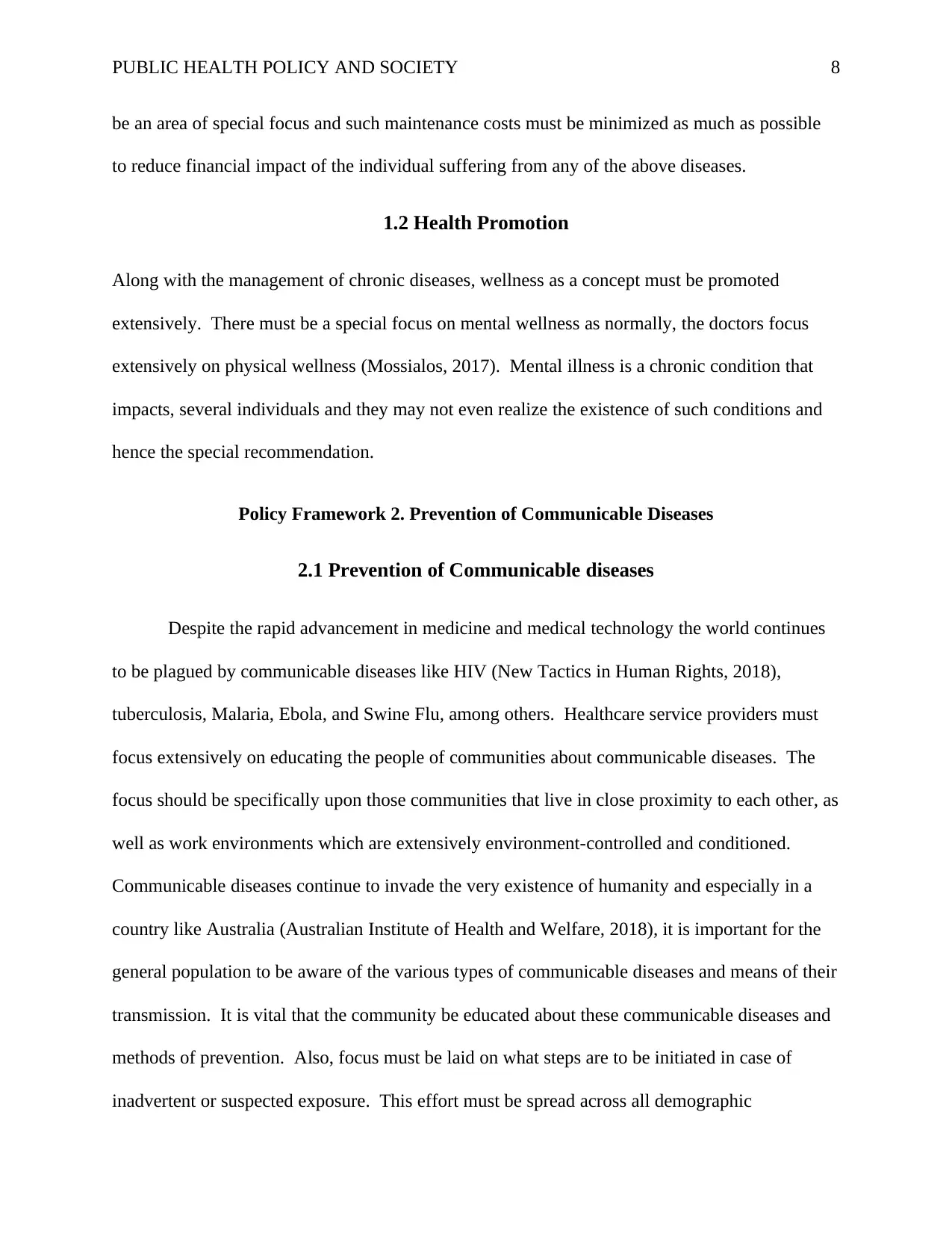
PUBLIC HEALTH POLICY AND SOCIETY 8
be an area of special focus and such maintenance costs must be minimized as much as possible
to reduce financial impact of the individual suffering from any of the above diseases.
1.2 Health Promotion
Along with the management of chronic diseases, wellness as a concept must be promoted
extensively. There must be a special focus on mental wellness as normally, the doctors focus
extensively on physical wellness (Mossialos, 2017). Mental illness is a chronic condition that
impacts, several individuals and they may not even realize the existence of such conditions and
hence the special recommendation.
Policy Framework 2. Prevention of Communicable Diseases
2.1 Prevention of Communicable diseases
Despite the rapid advancement in medicine and medical technology the world continues
to be plagued by communicable diseases like HIV (New Tactics in Human Rights, 2018),
tuberculosis, Malaria, Ebola, and Swine Flu, among others. Healthcare service providers must
focus extensively on educating the people of communities about communicable diseases. The
focus should be specifically upon those communities that live in close proximity to each other, as
well as work environments which are extensively environment-controlled and conditioned.
Communicable diseases continue to invade the very existence of humanity and especially in a
country like Australia (Australian Institute of Health and Welfare, 2018), it is important for the
general population to be aware of the various types of communicable diseases and means of their
transmission. It is vital that the community be educated about these communicable diseases and
methods of prevention. Also, focus must be laid on what steps are to be initiated in case of
inadvertent or suspected exposure. This effort must be spread across all demographic
be an area of special focus and such maintenance costs must be minimized as much as possible
to reduce financial impact of the individual suffering from any of the above diseases.
1.2 Health Promotion
Along with the management of chronic diseases, wellness as a concept must be promoted
extensively. There must be a special focus on mental wellness as normally, the doctors focus
extensively on physical wellness (Mossialos, 2017). Mental illness is a chronic condition that
impacts, several individuals and they may not even realize the existence of such conditions and
hence the special recommendation.
Policy Framework 2. Prevention of Communicable Diseases
2.1 Prevention of Communicable diseases
Despite the rapid advancement in medicine and medical technology the world continues
to be plagued by communicable diseases like HIV (New Tactics in Human Rights, 2018),
tuberculosis, Malaria, Ebola, and Swine Flu, among others. Healthcare service providers must
focus extensively on educating the people of communities about communicable diseases. The
focus should be specifically upon those communities that live in close proximity to each other, as
well as work environments which are extensively environment-controlled and conditioned.
Communicable diseases continue to invade the very existence of humanity and especially in a
country like Australia (Australian Institute of Health and Welfare, 2018), it is important for the
general population to be aware of the various types of communicable diseases and means of their
transmission. It is vital that the community be educated about these communicable diseases and
methods of prevention. Also, focus must be laid on what steps are to be initiated in case of
inadvertent or suspected exposure. This effort must be spread across all demographic
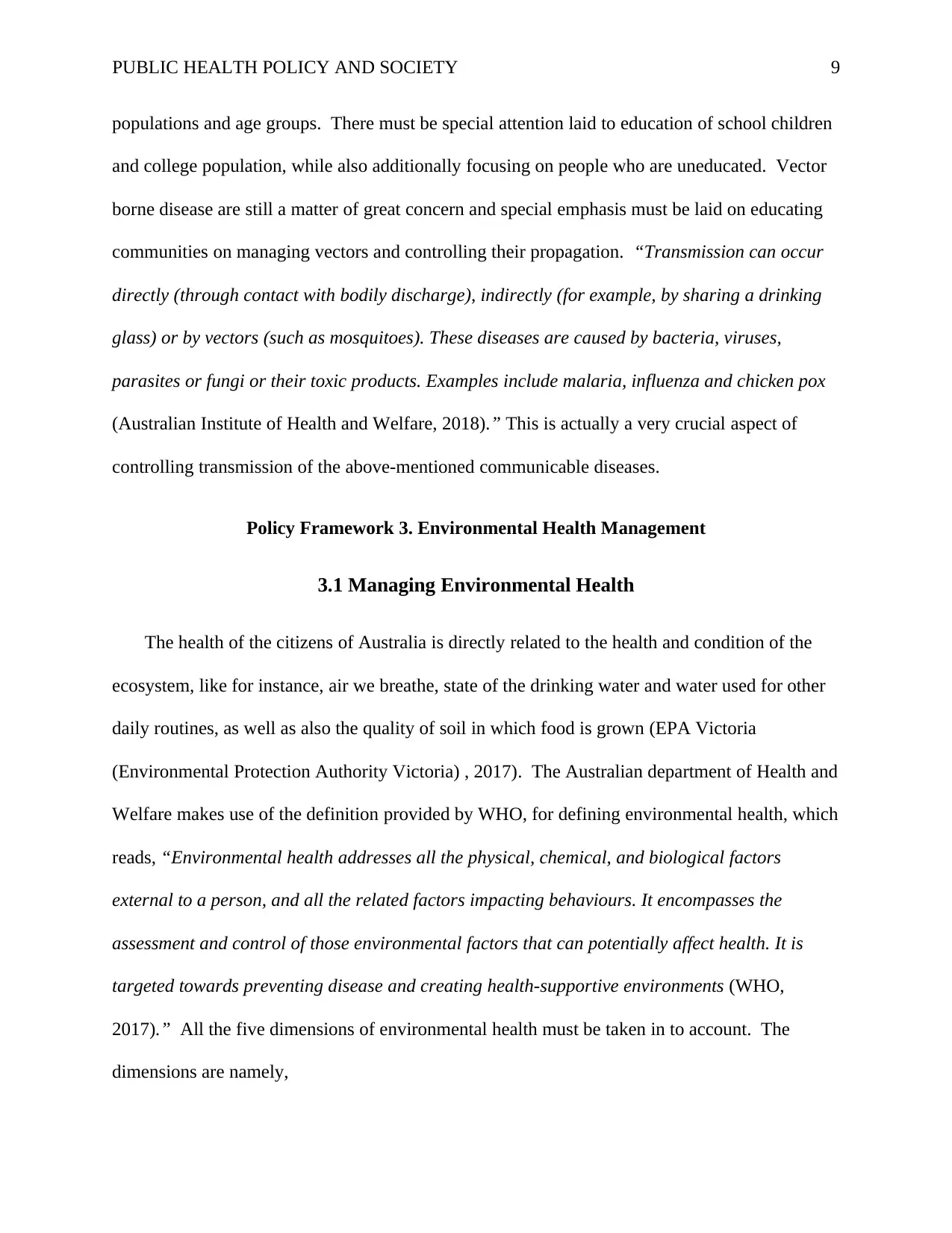
PUBLIC HEALTH POLICY AND SOCIETY 9
populations and age groups. There must be special attention laid to education of school children
and college population, while also additionally focusing on people who are uneducated. Vector
borne disease are still a matter of great concern and special emphasis must be laid on educating
communities on managing vectors and controlling their propagation. “Transmission can occur
directly (through contact with bodily discharge), indirectly (for example, by sharing a drinking
glass) or by vectors (such as mosquitoes). These diseases are caused by bacteria, viruses,
parasites or fungi or their toxic products. Examples include malaria, influenza and chicken pox
(Australian Institute of Health and Welfare, 2018).” This is actually a very crucial aspect of
controlling transmission of the above-mentioned communicable diseases.
Policy Framework 3. Environmental Health Management
3.1 Managing Environmental Health
The health of the citizens of Australia is directly related to the health and condition of the
ecosystem, like for instance, air we breathe, state of the drinking water and water used for other
daily routines, as well as also the quality of soil in which food is grown (EPA Victoria
(Environmental Protection Authority Victoria) , 2017). The Australian department of Health and
Welfare makes use of the definition provided by WHO, for defining environmental health, which
reads, “Environmental health addresses all the physical, chemical, and biological factors
external to a person, and all the related factors impacting behaviours. It encompasses the
assessment and control of those environmental factors that can potentially affect health. It is
targeted towards preventing disease and creating health-supportive environments (WHO,
2017).” All the five dimensions of environmental health must be taken in to account. The
dimensions are namely,
populations and age groups. There must be special attention laid to education of school children
and college population, while also additionally focusing on people who are uneducated. Vector
borne disease are still a matter of great concern and special emphasis must be laid on educating
communities on managing vectors and controlling their propagation. “Transmission can occur
directly (through contact with bodily discharge), indirectly (for example, by sharing a drinking
glass) or by vectors (such as mosquitoes). These diseases are caused by bacteria, viruses,
parasites or fungi or their toxic products. Examples include malaria, influenza and chicken pox
(Australian Institute of Health and Welfare, 2018).” This is actually a very crucial aspect of
controlling transmission of the above-mentioned communicable diseases.
Policy Framework 3. Environmental Health Management
3.1 Managing Environmental Health
The health of the citizens of Australia is directly related to the health and condition of the
ecosystem, like for instance, air we breathe, state of the drinking water and water used for other
daily routines, as well as also the quality of soil in which food is grown (EPA Victoria
(Environmental Protection Authority Victoria) , 2017). The Australian department of Health and
Welfare makes use of the definition provided by WHO, for defining environmental health, which
reads, “Environmental health addresses all the physical, chemical, and biological factors
external to a person, and all the related factors impacting behaviours. It encompasses the
assessment and control of those environmental factors that can potentially affect health. It is
targeted towards preventing disease and creating health-supportive environments (WHO,
2017).” All the five dimensions of environmental health must be taken in to account. The
dimensions are namely,
⊘ This is a preview!⊘
Do you want full access?
Subscribe today to unlock all pages.

Trusted by 1+ million students worldwide
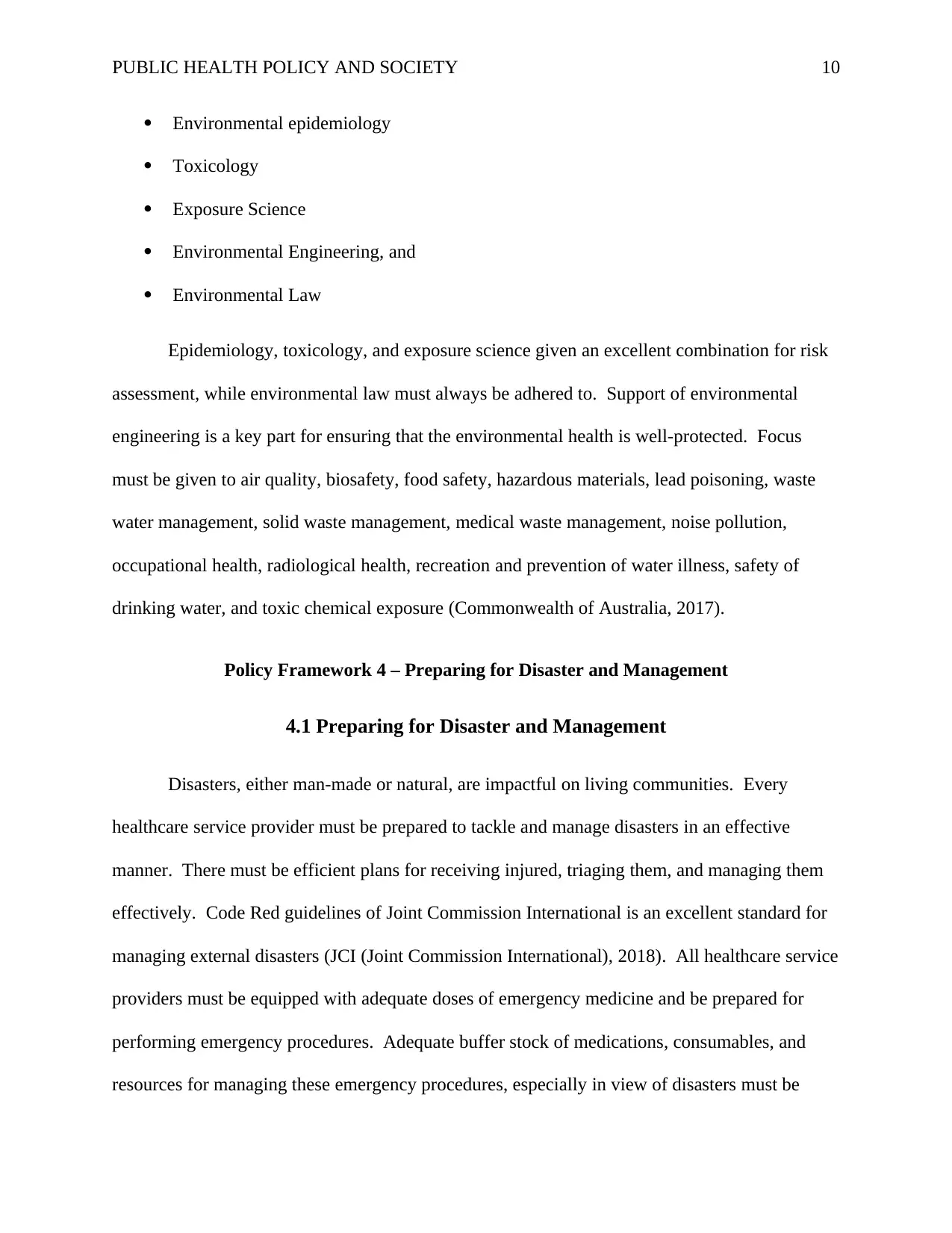
PUBLIC HEALTH POLICY AND SOCIETY 10
Environmental epidemiology
Toxicology
Exposure Science
Environmental Engineering, and
Environmental Law
Epidemiology, toxicology, and exposure science given an excellent combination for risk
assessment, while environmental law must always be adhered to. Support of environmental
engineering is a key part for ensuring that the environmental health is well-protected. Focus
must be given to air quality, biosafety, food safety, hazardous materials, lead poisoning, waste
water management, solid waste management, medical waste management, noise pollution,
occupational health, radiological health, recreation and prevention of water illness, safety of
drinking water, and toxic chemical exposure (Commonwealth of Australia, 2017).
Policy Framework 4 – Preparing for Disaster and Management
4.1 Preparing for Disaster and Management
Disasters, either man-made or natural, are impactful on living communities. Every
healthcare service provider must be prepared to tackle and manage disasters in an effective
manner. There must be efficient plans for receiving injured, triaging them, and managing them
effectively. Code Red guidelines of Joint Commission International is an excellent standard for
managing external disasters (JCI (Joint Commission International), 2018). All healthcare service
providers must be equipped with adequate doses of emergency medicine and be prepared for
performing emergency procedures. Adequate buffer stock of medications, consumables, and
resources for managing these emergency procedures, especially in view of disasters must be
Environmental epidemiology
Toxicology
Exposure Science
Environmental Engineering, and
Environmental Law
Epidemiology, toxicology, and exposure science given an excellent combination for risk
assessment, while environmental law must always be adhered to. Support of environmental
engineering is a key part for ensuring that the environmental health is well-protected. Focus
must be given to air quality, biosafety, food safety, hazardous materials, lead poisoning, waste
water management, solid waste management, medical waste management, noise pollution,
occupational health, radiological health, recreation and prevention of water illness, safety of
drinking water, and toxic chemical exposure (Commonwealth of Australia, 2017).
Policy Framework 4 – Preparing for Disaster and Management
4.1 Preparing for Disaster and Management
Disasters, either man-made or natural, are impactful on living communities. Every
healthcare service provider must be prepared to tackle and manage disasters in an effective
manner. There must be efficient plans for receiving injured, triaging them, and managing them
effectively. Code Red guidelines of Joint Commission International is an excellent standard for
managing external disasters (JCI (Joint Commission International), 2018). All healthcare service
providers must be equipped with adequate doses of emergency medicine and be prepared for
performing emergency procedures. Adequate buffer stock of medications, consumables, and
resources for managing these emergency procedures, especially in view of disasters must be
Paraphrase This Document
Need a fresh take? Get an instant paraphrase of this document with our AI Paraphraser
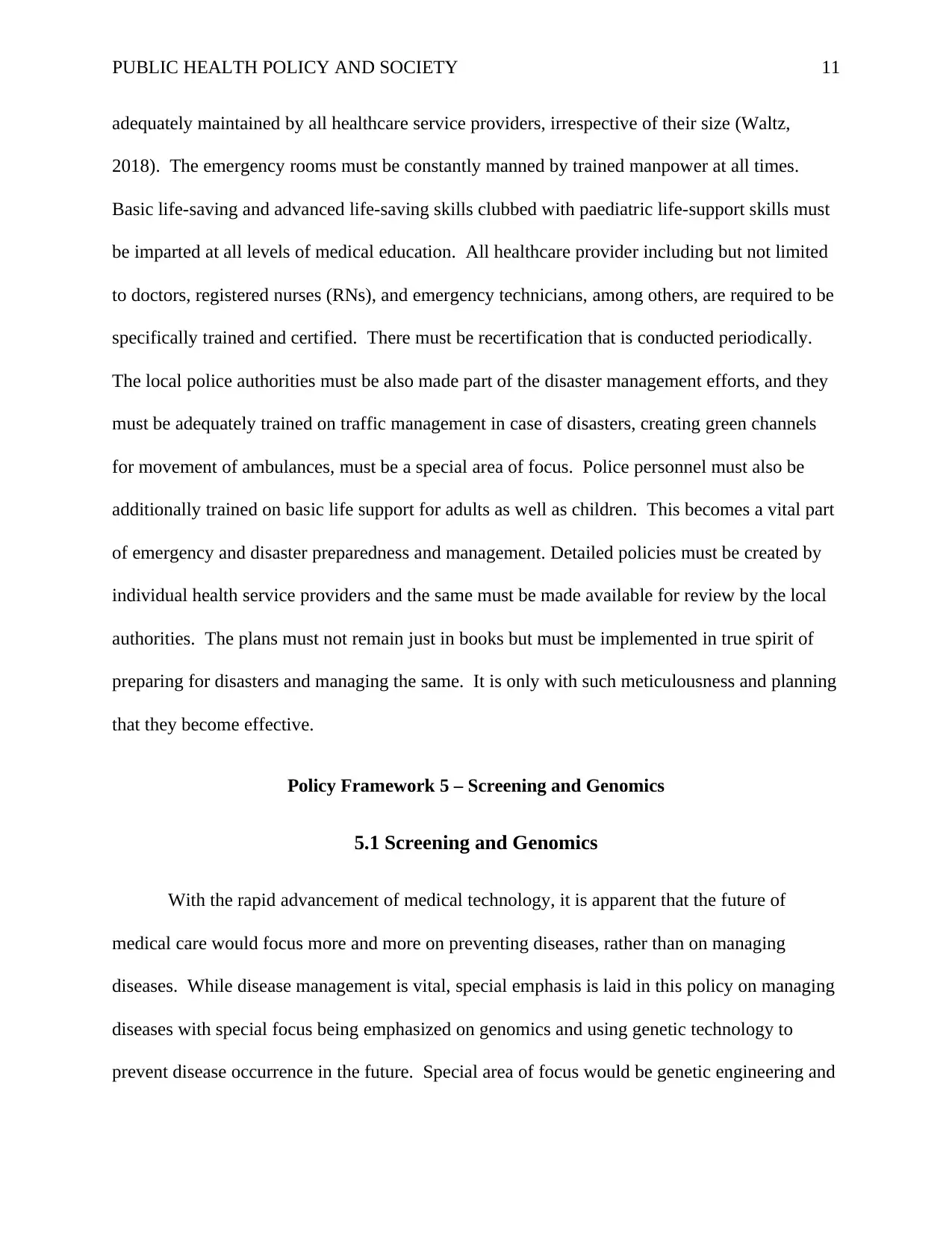
PUBLIC HEALTH POLICY AND SOCIETY 11
adequately maintained by all healthcare service providers, irrespective of their size (Waltz,
2018). The emergency rooms must be constantly manned by trained manpower at all times.
Basic life-saving and advanced life-saving skills clubbed with paediatric life-support skills must
be imparted at all levels of medical education. All healthcare provider including but not limited
to doctors, registered nurses (RNs), and emergency technicians, among others, are required to be
specifically trained and certified. There must be recertification that is conducted periodically.
The local police authorities must be also made part of the disaster management efforts, and they
must be adequately trained on traffic management in case of disasters, creating green channels
for movement of ambulances, must be a special area of focus. Police personnel must also be
additionally trained on basic life support for adults as well as children. This becomes a vital part
of emergency and disaster preparedness and management. Detailed policies must be created by
individual health service providers and the same must be made available for review by the local
authorities. The plans must not remain just in books but must be implemented in true spirit of
preparing for disasters and managing the same. It is only with such meticulousness and planning
that they become effective.
Policy Framework 5 – Screening and Genomics
5.1 Screening and Genomics
With the rapid advancement of medical technology, it is apparent that the future of
medical care would focus more and more on preventing diseases, rather than on managing
diseases. While disease management is vital, special emphasis is laid in this policy on managing
diseases with special focus being emphasized on genomics and using genetic technology to
prevent disease occurrence in the future. Special area of focus would be genetic engineering and
adequately maintained by all healthcare service providers, irrespective of their size (Waltz,
2018). The emergency rooms must be constantly manned by trained manpower at all times.
Basic life-saving and advanced life-saving skills clubbed with paediatric life-support skills must
be imparted at all levels of medical education. All healthcare provider including but not limited
to doctors, registered nurses (RNs), and emergency technicians, among others, are required to be
specifically trained and certified. There must be recertification that is conducted periodically.
The local police authorities must be also made part of the disaster management efforts, and they
must be adequately trained on traffic management in case of disasters, creating green channels
for movement of ambulances, must be a special area of focus. Police personnel must also be
additionally trained on basic life support for adults as well as children. This becomes a vital part
of emergency and disaster preparedness and management. Detailed policies must be created by
individual health service providers and the same must be made available for review by the local
authorities. The plans must not remain just in books but must be implemented in true spirit of
preparing for disasters and managing the same. It is only with such meticulousness and planning
that they become effective.
Policy Framework 5 – Screening and Genomics
5.1 Screening and Genomics
With the rapid advancement of medical technology, it is apparent that the future of
medical care would focus more and more on preventing diseases, rather than on managing
diseases. While disease management is vital, special emphasis is laid in this policy on managing
diseases with special focus being emphasized on genomics and using genetic technology to
prevent disease occurrence in the future. Special area of focus would be genetic engineering and
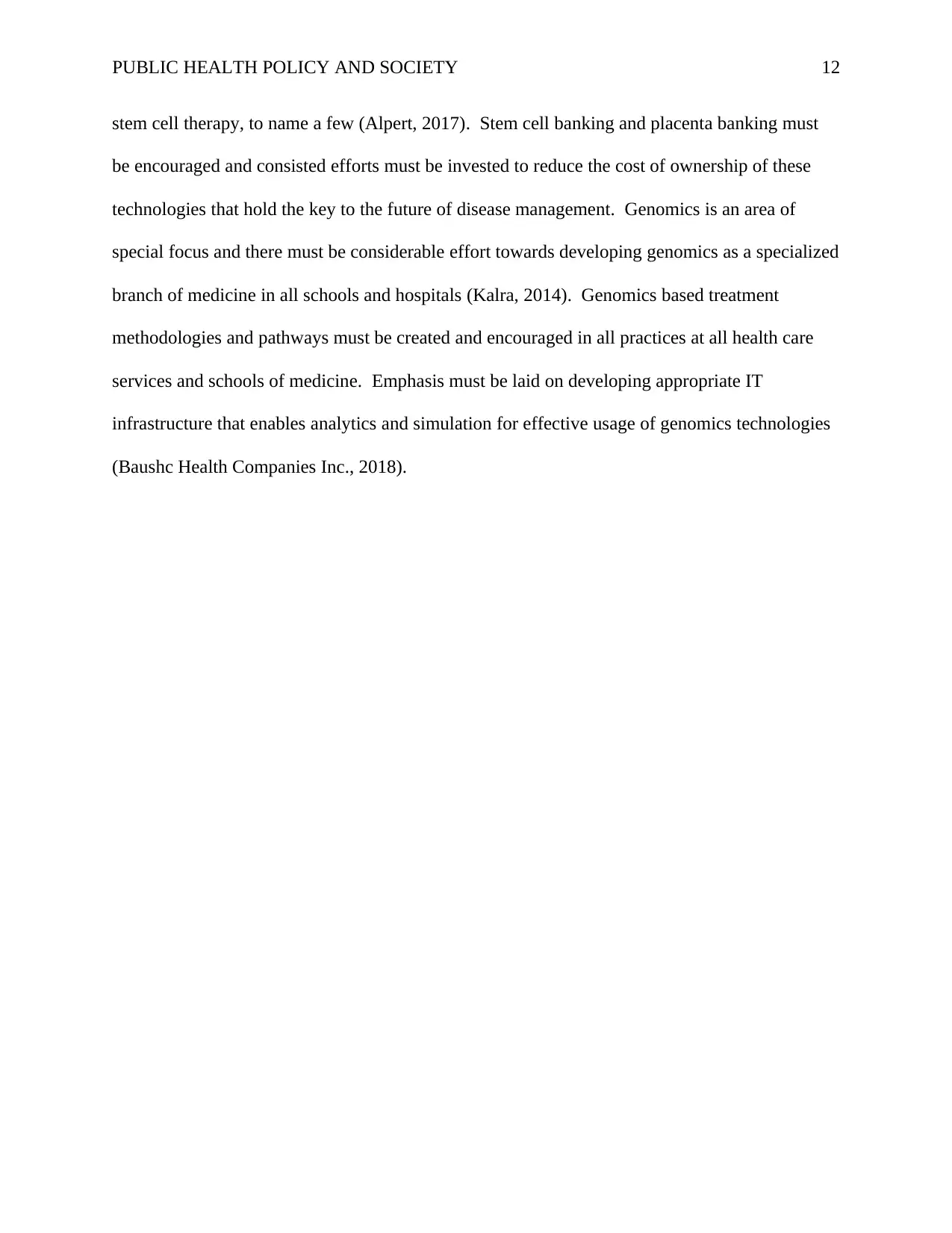
PUBLIC HEALTH POLICY AND SOCIETY 12
stem cell therapy, to name a few (Alpert, 2017). Stem cell banking and placenta banking must
be encouraged and consisted efforts must be invested to reduce the cost of ownership of these
technologies that hold the key to the future of disease management. Genomics is an area of
special focus and there must be considerable effort towards developing genomics as a specialized
branch of medicine in all schools and hospitals (Kalra, 2014). Genomics based treatment
methodologies and pathways must be created and encouraged in all practices at all health care
services and schools of medicine. Emphasis must be laid on developing appropriate IT
infrastructure that enables analytics and simulation for effective usage of genomics technologies
(Baushc Health Companies Inc., 2018).
stem cell therapy, to name a few (Alpert, 2017). Stem cell banking and placenta banking must
be encouraged and consisted efforts must be invested to reduce the cost of ownership of these
technologies that hold the key to the future of disease management. Genomics is an area of
special focus and there must be considerable effort towards developing genomics as a specialized
branch of medicine in all schools and hospitals (Kalra, 2014). Genomics based treatment
methodologies and pathways must be created and encouraged in all practices at all health care
services and schools of medicine. Emphasis must be laid on developing appropriate IT
infrastructure that enables analytics and simulation for effective usage of genomics technologies
(Baushc Health Companies Inc., 2018).
⊘ This is a preview!⊘
Do you want full access?
Subscribe today to unlock all pages.

Trusted by 1+ million students worldwide
1 out of 17
Related Documents
Your All-in-One AI-Powered Toolkit for Academic Success.
+13062052269
info@desklib.com
Available 24*7 on WhatsApp / Email
![[object Object]](/_next/static/media/star-bottom.7253800d.svg)
Unlock your academic potential
Copyright © 2020–2025 A2Z Services. All Rights Reserved. Developed and managed by ZUCOL.





